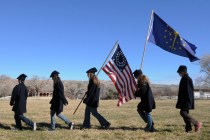Corn Creek Field Station offers taste of nature near valley
Springtime arrives at Corn Creek Field Station with a flush of green in the pastures, a froth of flowers in the orchard and a flurry of wings in the tules. The major access to the sprawling Desert National Wildlife Range just north of Las Vegas, Corn Creek provides an introduction to the largest federal wildlife refuge in the country outside of Alaska. Created in 1936 as a refuge for the desert bighorn sheep, the range also protects many other species under the management of the U.S. Fish and Wildlife Service.
Located at the base of the Sheep Range, Corn Creek lies just minutes away from downtown Las Vegas. Follow U.S. 95 north 10 miles past the Kyle Canyon turnoff. Exit onto Corn Creek Road, a graded side road that runs about six miles to the Corn Creek Station parking area. Graded roads lead away from Corn Creek into remote desert valleys and mountain ranges contained within the 1.6 million acres of the Desert National Wildlife Range.
The southern border of the huge refuge lies near the northernmost city limits of Las Vegas. It extends north into Lincoln County near Alamo. Bordered by U.S. 95 and the Nevada Test Site on the west, it extends east to U.S. 93. Nearly half of its acreage overlaps the Nellis Air Force Range, an area with safety and security needs that somewhat hamper wildlife and habitat management. It remains as undeveloped as in pioneer times, except for a few rough roads and enhanced water resources for wildlife, such as roofed guzzlers or catch basins. Some of these water sources are located in areas so remote that work crews must be transported by helicopter.
Visitors to the refuge annually number about 68,000 people, most never getting farther than Corn Creek Station. Anyone venturing into the outback of the Desert National Wildlife Range generally has it pretty much to himself. It attracts adventurous and self-sufficient horseback trail riders, photographers, backpackers, primitive campers, wildlife watchers and hunters who draw the few permits issued for the range.
When you park, sign the register. Visitors pay no entrance fee. Restrooms are located nearby. On one side, a small building serves as a visitor center open Fridays from 10 a.m. to 2 p.m. On the other side, a roofed kiosk invites investigation. Large exhibits outline the purpose of the wildlife range, the plants and animals found there, the various habitats from Corn Creek to the nearly 10,000-foot mountain peaks and some history of the area.
Corn Creek has been drawing human visitors for about 10,000 years. Its abundant water and varied native plants drew wildlife and birds, attractions that early caught the attention of native people who survived by food gathering and hunting. A few might even have planted plots of beans, squash and corn in well-watered places there. Corn Creek later became one of several ranches established by early non-native settlers in the Las Vegas Valley. Its location put it on the route of stage and freight lines that linked Nevada’s scattered communities before highways were built. In 1939, it became part of the new wildlife range.
Beyond the kiosk, graveled trails meander along a creek, past ponds crowded with marshy growth, through an old orchard and past a small building housing an outdoor aquarium, a refugium, last home of the endangered Pahrump poolfish. This small native fish is one of several threatened or endangered animals and plants protected within the Desert National Wildlife Range.
No matter what time of year you visit Corn Creek, birds will be the most evident wild creatures on hand. The varied habitat, water and abundant food sources bring bird species to this oasis by the hundreds. Corn Creek Station remains a favorite of local birders, especially during spring and fall migrations.
If you move quietly or sit on one of the trailside benches for a few minutes, the wary wildlife show themselves. You’ll hear waterfowl among the reeds. You’ll spot songbirds winging between trees. You’ll note feathered hunters overhead. You may even come face to face with an amber-eyed, four-footed hunter.
Margo Bartlett Pesek’s column appears on Sundays.


















